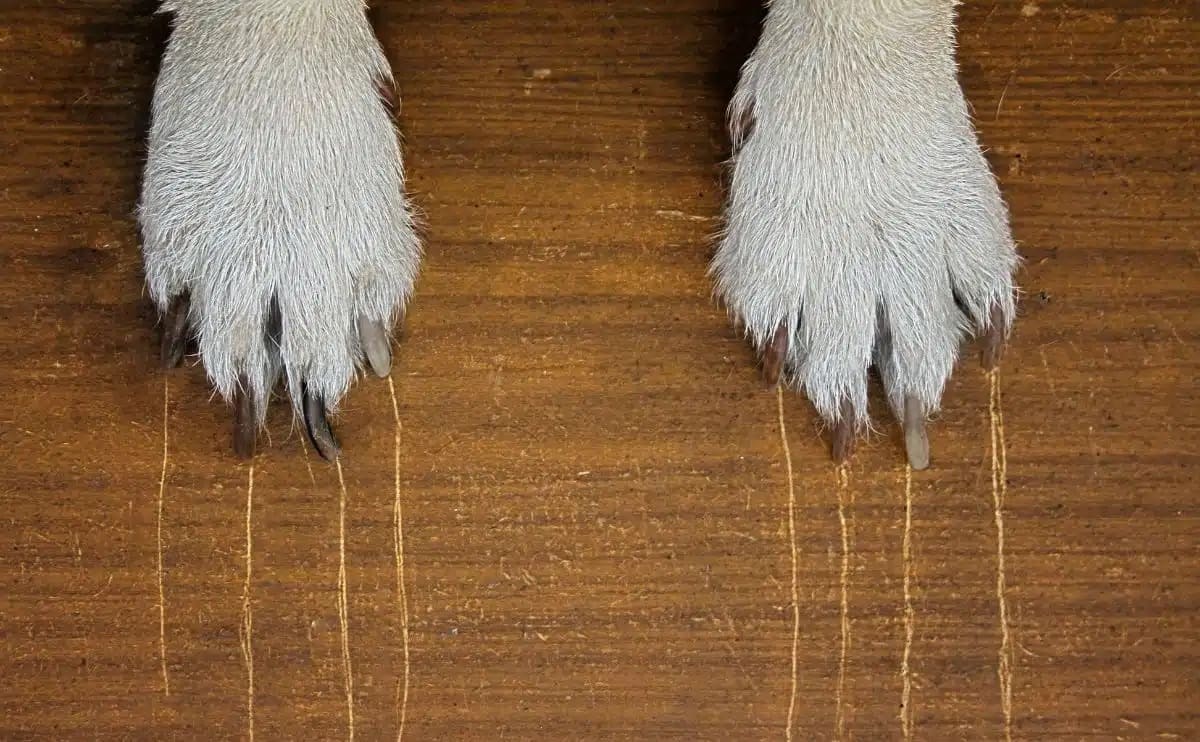Home>Furniture>Bedroom Furniture>Why Do Dogs Sleep At The Foot Of The Bed


Bedroom Furniture
Why Do Dogs Sleep At The Foot Of The Bed
Modified: December 7, 2023
Discover the reason behind why dogs prefer sleeping at the foot of the bed. Explore our wide selection of bedroom furniture to create a cozy space for your furry friend.
(Many of the links in this article redirect to a specific reviewed product. Your purchase of these products through affiliate links helps to generate commission for Storables.com, at no extra cost. Learn more)
Introduction
It’s a familiar scene for many pet owners – you crawl into bed after a long day, only to find your furry friend snuggled at the foot of the bed. Dogs have been known for their affinity for sleeping at the foot of the bed, but have you ever wondered why they prefer this spot? In this article, we will explore the historical significance, evolutionary reasons, and the comfort and security factors that contribute to dogs seeking out the foot of the bed for their slumber.
Throughout history, dogs have been loyal companions to humans, and their presence in our bedrooms dates back centuries. In ancient times, dogs were often used for protection and would sleep at the foot of the bed to guard their owners from any potential threats. This positioning provided a sense of security and alerted the owner to any potential danger during the night.
Key Takeaways:
- Dogs historically slept at the foot of beds for protection and loyalty, dating back to ancient civilizations. This practice aligns with their pack instincts and provides comfort and security for both dogs and owners.
- Encouraging dogs to sleep at the foot of the bed can strengthen the bond between dogs and owners, reduce anxiety, and enhance the sense of security. However, it’s important to respect individual preferences and provide alternative sleeping arrangements if needed.
Read more: Why Do Cats Sleep At The Foot Of The Bed
Historical significance of dogs sleeping at the foot of the bed
The practice of dogs sleeping at the foot of the bed has deep historical roots. In ancient civilizations, such as Egypt and Rome, dogs were highly revered and valued for their loyalty, protection, and companionship. Dogs were often regarded as more than just pets – they were seen as esteemed members of the family. In these cultures, it was common for dogs to sleep at the foot of their owner’s bed, serving as both a guardian and a symbol of loyalty.
In ancient Egypt, for example, dogs were associated with Anubis, the god of the afterlife. It was believed that having a dog at the foot of one’s bed would provide protection and guide the soul safely into the afterlife. This belief was so ingrained in Egyptian culture that dogs were often buried alongside their owners, further emphasizing their sacred role.
In medieval Europe, the practice of dogs sleeping at the foot of the bed continued. Dogs were cherished for their ability to protect the household from intruders and alert the family to potential dangers. The foot of the bed was considered the ideal position for the dog, as it allowed them to maintain a watchful eye over their owners while also providing comfort and companionship.
Furthermore, dogs were often associated with the nobility and royalty. They would sleep at the foot of their owners’ beds as a symbol of their status and loyalty. The presence of a dog at the foot of the bed was not only a sign of protection but also a demonstration of the owner’s wealth and prestige.
This historical significance of dogs sleeping at the foot of the bed has carried forward into modern times. While the practical need for protection may have diminished, the emotional and symbolic meaning remains. Dogs continue to be seen as loyal companions and their presence at the foot of the bed can provide a sense of security and comfort for their owners.
Evolutionary reasons for dogs sleeping at the foot of the bed
While the historical significance of dogs sleeping at the foot of the bed is fascinating, there are also evolutionary reasons that contribute to this behavior. Dogs, as descendants of wolves, are pack animals with a strong instinct to seek out the comfort and safety of a group. Sleeping at the foot of the bed is a way for them to fulfill this instinctual need.
In the wild, wolves sleep together in a pack for protection, warmth, and social bonding. By sleeping in close proximity to each other, wolves can ward off potential threats and regulate their body temperature more efficiently. This behavior has carried over to domesticated dogs, who often see their human family as their pack.
When a dog sleeps at the foot of the bed, they are essentially positioning themselves as a member of the pack. They feel a sense of security and belonging by being close to their owners during the vulnerable state of sleep. This behavior is especially pronounced in breeds that have a strong pack mentality, such as huskies or German shepherds.
Moreover, dogs have a keen sense of smell and are highly attuned to their owners’ scents. Sleeping at the foot of the bed allows them to be in close proximity to their owners, providing them with a familiar and comforting scent. This can help to reduce anxiety and create a soothing atmosphere for better sleep.
Additionally, the act of dogs sleeping at the foot of the bed can strengthen the bond between dog and owner. The close physical proximity promotes feelings of affection and companionship. It also allows for physical contact during the night, such as touching or cuddling, which releases oxytocin – the “love hormone” – in both humans and dogs. This hormone has been linked to promoting feelings of trust and bonding.
Overall, the evolutionary reasons for dogs sleeping at the foot of the bed can be attributed to their pack instincts, sense of security, and the desire for social bonding. Understanding these reasons can help pet owners better understand and accommodate their furry friends’ needs for comfort and companionship during sleep time.
Comfort and security factors for dogs
There are several comfort and security factors that contribute to dogs’ preference for sleeping at the foot of the bed. Understanding these factors can help pet owners provide a sleeping environment that promotes their dogs’ well-being and enhances their sleep quality.
One of the key factors is the physical comfort provided by the bed itself. The foot of the bed often offers a soft and cushioned surface, which dogs find comfortable for resting. It provides a cozy spot that supports their joints and muscles, allowing them to relax and get a good night’s sleep.
Additionally, dogs are creatures of routine and habit. Sleeping at the foot of the bed becomes part of their established routine, and the familiarity of the location can provide them with a sense of comfort and security. They feel safe and protected in their designated spot, surrounded by the familiar scents and sights of the bedroom.
Furthermore, dogs are social animals that thrive on companionship. Sharing sleeping space with their owners allows them to fulfill their need for social connection and can help alleviate feelings of loneliness or separation anxiety. The presence of their human family member provides a sense of security and reassurance, reducing stress levels and promoting a sense of calmness during sleep.
For some dogs, sleeping at the foot of the bed can also help alleviate certain anxieties or fears. Being close to their owners allows them to feel protected and less vulnerable to potential threats or disturbances during the night. This can be particularly beneficial for dogs with anxiety disorders or those who have had traumatic experiences in the past.
It’s important to note that while many dogs find comfort and security in sleeping at the foot of the bed, it may not be the case for all dogs. Some may have personal preferences or feel more comfortable in their own designated sleeping areas. It’s essential to observe and understand your dog’s individual needs and preferences to create a sleeping environment that best suits them.
By considering the physical comfort, routine, social connection, and anxiety-reducing benefits, pet owners can create a sleep space that promotes their dog’s well-being while fostering a strong bond between dog and owner.
Bonding and pack instinct in dogs
Dogs are social animals with a strong pack instinct, which plays a significant role in their behavior and sleeping preferences. Understanding the concepts of bonding and pack instinct can shed light on why dogs seek out close proximity to their human pack members, including sleeping at the foot of the bed.
Bonding is a fundamental aspect of the human-dog relationship. Dogs have a remarkable ability to form deep emotional bonds with their owners. This bond is facilitated by various factors, including consistent care, positive interactions, and a sense of security. Sleeping together, or in close proximity, helps strengthen the bond between dogs and their owners.
When dogs sleep at the foot of the bed, they are physically and emotionally connected to their owners. The close proximity allows for touch, which releases oxytocin (the “love hormone”) in both humans and dogs. This hormone plays a crucial role in strengthening the bond and promoting positive feelings of trust, love, and attachment.
The pack instinct in dogs stems from their ancestry as descendants of wolves. In the wild, wolves live in packs and depend on each other for survival. The pack serves as a social structure that provides safety, cooperation, and a sense of belonging. This instinctual need for a pack is still present in domesticated dogs.
Sleeping at the foot of the bed allows dogs to fulfill their pack instinct. They see their human family members as their pack and want to be close to them at all times, even during sleep. This behavior creates a sense of security and enhances the bond within the pack unit.
Furthermore, sleeping together aligns with the natural hierarchical structure within a pack. In a pack, there is an alpha leader and subordinate members. By allowing a dog to sleep at the foot of the bed, the dog recognizes the owner as the alpha leader, reinforcing the pack structure and the dog’s sense of place.
It’s important to note that dogs may display different sleeping preferences based on their individual personalities and experiences. Some dogs may prefer to sleep closer to their owners, while others may feel more comfortable in their own designated sleeping areas. Recognizing and respecting your dog’s preferences will contribute to a healthy and balanced bond between dog and owner.
Overall, the bonding and pack instinct in dogs explain why they seek close proximity to their owners, including sleeping at the foot of the bed. By understanding and embracing these instincts, pet owners can strengthen their bond with their furry companions and create a sense of security and harmony within the pack unit.
Dogs may sleep at the foot of the bed as a natural instinct to protect their owners. It’s also a way for them to feel secure and have a sense of belonging within the pack.
Read more: Why Do Dogs Dig On The Bed
Benefits and disadvantages of dogs sleeping at the foot of the bed
Allowing dogs to sleep at the foot of the bed can have both benefits and potential disadvantages. Understanding these factors can help pet owners make informed decisions about whether or not to invite their furry friends into their sleeping space.
Benefits:
- Increased bonding: Sleeping in close proximity promotes bonding between dogs and their owners, strengthening the emotional connection and sense of companionship.
- Reduced anxiety: Dogs may feel more secure and less anxious when sleeping at the foot of the bed, as they are close to their owners and can draw comfort from their presence.
- Enhanced sense of security: Dogs instinctively seek out the foot of the bed for protection, benefiting from the perceived safety of being close to their owners during the night.
- Comfort and warmth: Sharing the bed can provide dogs with a soft and comfortable surface to sleep on, as well as the warmth generated by their owners’ body heat.
- Reduced loneliness: Being in close proximity to their owners while sleeping can help alleviate feelings of loneliness and separation anxiety in dogs.
Disadvantages:
- Disrupted sleep: Dogs may move around, snore, or take up space, potentially disturbing their owners’ sleep and creating inconvenience.
- Allergies and hygiene: Sharing the bed with a dog can exacerbate allergies or contribute to a less hygienic sleeping environment, especially for individuals with respiratory sensitivities.
- Space limitations: Depending on the size of the bed and the dog, sleeping at the foot of the bed may result in cramped sleeping conditions for both the dog and the owner.
- Establishing boundaries: Inviting a dog into the bed can blur boundaries and potentially lead to behavioral issues if the dog becomes overly dependent on sleeping in the owner’s bed.
- Interrupted intimacy: For couples, the presence of a dog in the bed may impact intimacy and disrupt the private space typically associated with the bedroom.
Ultimately, whether the benefits outweigh the disadvantages or vice versa will depend on individual circumstances and personal preferences. It is important to consider factors such as personal comfort, allergies, sleep quality, and the dog’s behavior before making a decision regarding sleeping arrangements.
It is worth noting that there are alternatives to allowing dogs to sleep at the foot of the bed, such as providing them with their own designated sleeping area nearby or allowing them access to a comfortable dog bed in the bedroom. This can ensure the dog’s comfort and security while also maintaining a balanced sleeping environment for both the dog and the owner.
Tips for encouraging dogs to sleep at the foot of the bed
If you would like to encourage your dog to sleep at the foot of the bed, there are several strategies you can try. However, it’s important to note that each dog is unique, and not all dogs may take to this arrangement. Here are some tips to help encourage your dog to sleep at the foot of the bed:
- Create a comfortable sleeping area: Make sure the foot of the bed is a cozy and inviting spot for your dog. Provide a soft blanket or dog bed that is specifically designated for their use. Make it a comfortable and appealing space by adding their favorite toys or a familiar scent.
- Establish a consistent routine: Dogs thrive on routine, so establish a consistent bedtime routine that includes going to the foot of the bed. By creating a predictable routine, your dog will come to associate this spot with bedtime and begin to seek it out on their own.
- Use positive reinforcement: Reward your dog for going to the foot of the bed and staying there. Offer verbal praise, treats, or affection whenever they choose to sleep in that spot. Positive reinforcement will help reinforce the behavior you want to encourage.
- Guide them to the foot of the bed: Initially, gently guide your dog to the foot of the bed when it is time to sleep. Use a command or cue, such as “go to your spot,” and provide treats or praise when they follow the command. Over time, they will learn to associate the command with going to the foot of the bed on their own.
- Make the foot of the bed appealing: Help your dog understand that the foot of the bed is a desirable sleeping spot. You can place their favorite blanket or a piece of clothing with your scent at the foot of the bed. This will make it more comforting and appealing for them to sleep in that area.
- Consider crate training: If your dog is not adjusting to sleeping at the foot of the bed, you may want to consider crate training. Provide a comfortable crate or dog bed near the foot of the bed as an alternative sleeping spot. Gradually transition your dog from the crate to the foot of the bed by leaving the crate door open and encouraging them to explore and sleep at the foot of the bed when they are ready.
Remember, patience and consistency are key when trying to encourage a new sleeping habit. It may take some time for your dog to adjust and feel comfortable sleeping at the foot of the bed. Always be understanding of their individual preferences and ensure they have a sleeping space where they feel safe and secure.
If your dog does not take to sleeping at the foot of the bed, respect their boundaries and provide them with an alternative designated sleeping area. It’s more important for them to feel comfortable and secure in their sleeping spot than to adhere to a specific arrangement.
Read more: Why Does My Dog Like Sleeping Under The Bed
Conclusion
The practice of dogs sleeping at the foot of the bed holds both historical significance and evolutionary reasons. Dogs have been loyal companions throughout history, and their presence in our bedrooms dates back centuries. Sleeping at the foot of the bed has been associated with protection, status, and loyalty in ancient civilizations.
Evolutionarily, dogs’ pack instincts drive them to seek closeness and companionship, which is fulfilled by sleeping at the foot of the bed. Dogs feel secure, connected, and comforted when they are in close proximity to their owners, aligning with their natural need for social bonding and pack structure. This closeness strengthens the emotional bond between dog and owner and provides a sense of security and well-being.
While there are benefits to allowing dogs to sleep at the foot of the bed, such as increased bonding, reduced anxiety, and enhanced sense of security, there are also potential disadvantages, such as disrupted sleep, hygiene concerns, and space limitations. It is important for pet owners to weigh these factors and decide what sleeping arrangement works best for both them and their canine companions.
If you desire to encourage your dog to sleep at the foot of the bed, create a comfortable and inviting sleeping area, establish a consistent routine, use positive reinforcement, guide them to the foot of the bed, and make the space appealing to them. However, it is essential to respect your dog’s preferences and boundaries. If they do not feel comfortable sleeping at the foot of the bed, provide them with an alternative designated sleeping area that still allows for closeness and companionship.
In the end, the sleeping arrangement between dog and owner should prioritize the well-being and comfort of both parties. Whether your dog ends up sleeping at the foot of the bed or in a separate sleeping spot nearby, the most important aspect is fostering a loving and secure environment that strengthens the bond between human and canine.
Frequently Asked Questions about Why Do Dogs Sleep At The Foot Of The Bed
Was this page helpful?
At Storables.com, we guarantee accurate and reliable information. Our content, validated by Expert Board Contributors, is crafted following stringent Editorial Policies. We're committed to providing you with well-researched, expert-backed insights for all your informational needs.













